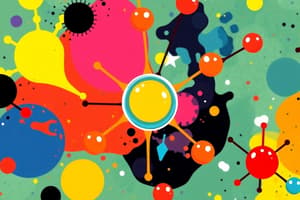Podcast
Questions and Answers
What is the term for atoms of an element that have the same number of protons and electrons but differ in the number of neutrons?
What is the term for atoms of an element that have the same number of protons and electrons but differ in the number of neutrons?
- Molecules
- Ions
- Noble Gases
- Isotopes (correct)
Which type of compound is formed when a non-metal reacts with a metal?
Which type of compound is formed when a non-metal reacts with a metal?
- Covalent Bond
- Noble Gas Compound
- Ionic Compound (correct)
- Molecular Compound
What is the term for the bond formed when two non-metal atoms share electrons?
What is the term for the bond formed when two non-metal atoms share electrons?
- Covalent Bond (correct)
- Electrostatic Bond
- Ionic Bond
- Molecular Bond
Which family of elements is known for being unreactive and having a full outer shell?
Which family of elements is known for being unreactive and having a full outer shell?
What is the general trend for the reactivity of metals in the periodic table?
What is the general trend for the reactivity of metals in the periodic table?
What is the general trend for the boiling points of elements in a period?
What is the general trend for the boiling points of elements in a period?
What is the term for the particles that make up the nucleus of an atom?
What is the term for the particles that make up the nucleus of an atom?
What is the maximum number of electrons that can be held in the first shell of an atom?
What is the maximum number of electrons that can be held in the first shell of an atom?
Study Notes
Counting Atoms and Molecules
- A molecule is formed when two or more atoms bond together
Isotopes
- Isotopes are atoms of an element with the same number of protons (atomic number) but differing numbers of neutrons, resulting in different atomic masses
- Neutrons can be calculated by subtracting the atomic number from the atomic mass
Ionic Compounds
- Ionic compounds are formed from the combination of ions (charged particles) with opposite charges
- Metals lose electrons to form cations, while non-metals gain electrons to form anions
- Ionic compounds are named with the metal followed by the non-metal with an "ide" ending
Molecular Compounds
- Molecular compounds are formed when two or more different elements bond together
- Example: Water (H2O) is a molecular compound
Molecular Bonds
- Covalent bonds form when two non-metal atoms share electrons to form a molecule
- The nucleus of one atom is attracted to the valence electrons of another atom, leading to electron sharing and bond formation
Noble Gases
- Noble gases are a family of elements in the 18th column of the periodic table
- They are stable and unreactive due to their full outer shell
Reactivity of Metals
- Metals closer to the edges of the periodic table are more reactive
- In the left side of the periodic table, higher periods indicate more reactivity
- In the right side of the periodic table, lower periods indicate more reactivity
Physical Properties of the Periodic Table
- Metals are typically found on the left side of the periodic table and have properties such as being shiny, malleable, and conductive
- Non-metals are typically found on the right side of the periodic table and have properties such as being dull, brittle, and insulating
- Metalloids are found on the border of the staircase and exhibit intermediate properties
Metals
- Metals are typically solid at room temperature
- They are shiny and malleable, and can conduct heat and electricity
Non-metals
- Non-metals can exist in solid, liquid, or gas states at room temperature
- They are dull, brittle, and insulating
Boiling Points
- Boiling points increase from left to right across a period due to increasing metallic bond strength
- Boiling points decrease for groups 1, 2, and 18 as you move down the periodic table
- Boiling points increase for group 17 as you move down the periodic table
Patterns of the Periodic Table
- Charges (family): +1, +2, (varies for 3-12), +3, +/-4, -3, -2, -1, 0
- Bonding capacity (family): 1, 2, (varies for 3-12), 3, 4, 3, 2, 1, 0
- Valence electrons (family): 1, 2, (varies for 3-12), 3, 4, 5, 6, 7, full
- Shells: increase by period, with period 1 having 1 shell, period 5 having 5 shells, etc.
Families
- Family 1: Alkali Metals
- Family 2: Alkaline Earth Metals
- Family 17: Halogens
- Family 18: Noble Gases
Subatomic Particles
- Atoms consist of protons and electrons, with protons never changing for an element
- Protons and electrons are equal in number for an atom
Bohr-Rutherford Diagram
- The first shell can hold up to 2 electrons
- The second and third shells can hold up to 8 electrons
- The nucleus consists of protons and neutrons
Studying That Suits You
Use AI to generate personalized quizzes and flashcards to suit your learning preferences.
Description
Test your understanding of basic chemistry concepts, including atoms, molecules, isotopes, and ionic compounds. Learn about the properties of atoms and how they combine to form molecules and compounds.




